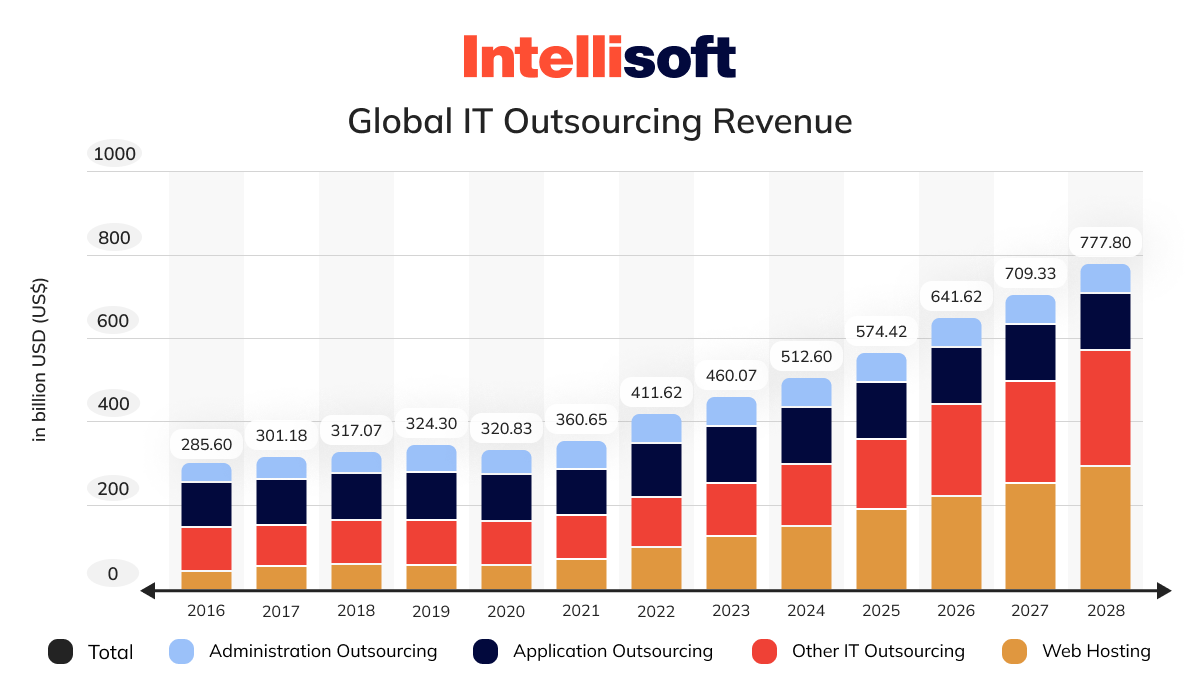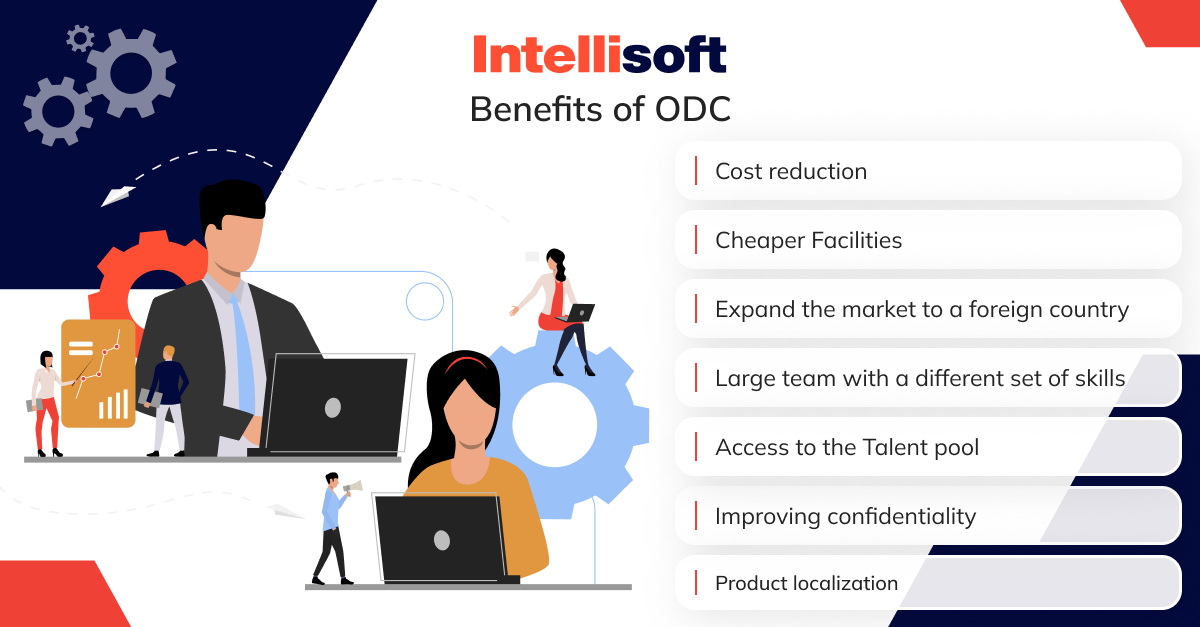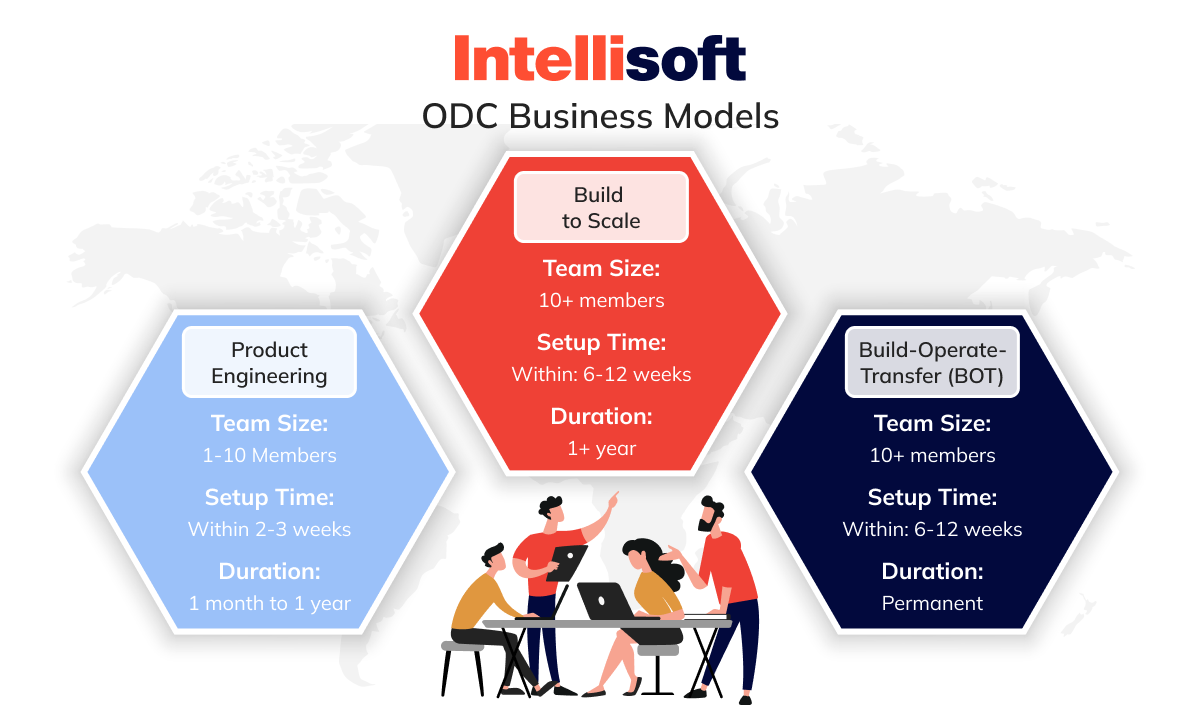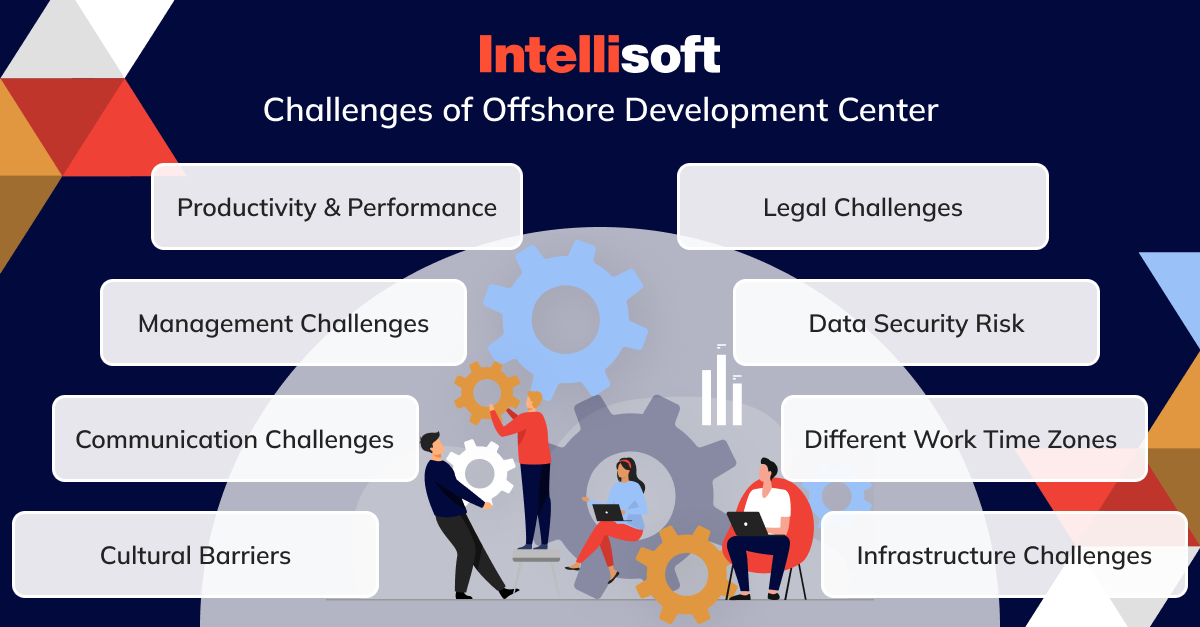With the IT world’s influence on the global economy getting stronger, more and more businesses are looking towards an offshore development center (ODC) model as a vital strategy. The desire for cost efficiency propels this shift towards technological innovation and strategic growth, the ability to tap into an international talent pool, and achieving high-quality outputs without a hefty price tag.

This path is set to redefine the IT landscape. Experts predict a significant increase in global IT outsourcing revenue, reaching $512 billion by the end of 2024. The market is expected to grow to $525 billion by 2030.
IntelliSoft has years of experience adapting to changes. Our legacy is built on guiding companies worldwide towards successful technological solutions, which places us at the heart of this evolving sector. In a world where 90% of G2000 companies are turning to outsourcing, and with over 70% of B2B companies in Europe and Britain outsourcing crucial operations, partnering with IntelliSoft becomes necessary for success.
In this article, we invite you to explore the offshore development center meaning and see why an ODC can become a key component of your business strategy.
Table of Contents
Understanding ODC – Offshore Development Center Concept
What exactly is an offshore software development center? Simply put, it’s like a branch of your company situated in another country, focusing on software development. This model offers a team of software engineers and specialists equipped with everything needed for comprehensive development tasks.
Businesses are increasingly adopting the offshore development center model, with projections suggesting the market could reach $283,457.5 million by 2030. This surge is attributed to the pursuit of cost-effective development and access to a broader talent pool, providing a solution to the tech sector’s challenge of local skill shortages.
Key Сharacteristics of ODC
Customization is at the core of ODCs, allowing for tailored security measures, team structure, and project management styles. ODCs are long-term oriented, focusing on building lasting partnerships rather than just completing single projects. They offer scalability, meaning you can adjust your team size based on project demands, ensuring flexible resource management.
An ODC operates self-sufficiently, encompassing developers and administrative and support personnel, making it a complete unit. Teams are dedicated, working solely on your projects, which enhances dedicated resources for commitment and goal alignment.
The Benefits of Offshore Development Centers
We can create an endless list of offshore development center benefits, but let’s focus on the main points.

Enhanced Risk Mitigation and Security
Tailor security protocols to your needs, offering better control over data and IP protection.
Global Talent Access
Tap into a worldwide talent pool, bypassing local shortages and boosting your development capabilities.
Cost Efficiency
Lower living and operational costs in certain regions can translate into significant savings.
Simplified Recruitment and Management
Streamline hiring and administrative processes, letting you focus on core business functions.
Local Market Insights
Gain a valuable understanding of local markets, potentially aiding in product expansion or customization.
Around-the-Clock Productivity
Leverage geographic diversity and different time zones for continuous work cycles to accelerate development and ensure constant support.
Complete Operational Control
Keep full oversight of your ODC, ensuring adherence to your standards and culture.
Choosing a reliable ODC partner, like IntelliSoft, means accessing our vast expertise and global network for your software development needs. With us, your ODC will become an extension of your team.
Main Offshore Development Center Models
Various types of offshore development center models are tailored to diverse business objectives and growth strategies. Let’s take a closer look at three main ODC models that stand out for their unique approaches to offshore expansion. Each model offers distinct advantages, fitting different phases of business development and strategic requirements.

Build-Operate-Transfer (BOT) Model
Think of the BOT model as a three-stage rocket to offshore development. It starts with the ’Build’ phase, where an ODC partner lays down the infrastructure and team foundation. Next, in the ’Operate’ phase, the partner manages daily operations while aligning with the client’s goals, keeping major decisions in the client’s hands. The process culminates in the ’Transfer’ phase, where the client takes full ownership, establishing their own foreign office. This model minimizes upfront risks, offering a “test the waters” approach with appealing stability for attracting and retaining top talent.
Build-To-Scale Model
Designed with a vision for growth, the Build-To-Scale model supports companies ready to move beyond intermittent outsourcing. It focuses on creating a dedicated, long-term development team to back scaling efforts. This model promises a stable ODC partnership for strategic and operational consistency. While it might take a bit longer to kick off, aiming to gather a committed and skilled team, the outcome is a resilient unit poised for scalable growth alongside the company.
Product Engineering Model
The Product Engineering Model offers a solution for those who don’t need a full-fledged team but extra hands to boost their existing teams. It supplements current teams with additional developers to fast-track development tasks. This model shines in its flexibility, allowing for quick adjustments in team size based on project demands and swift expansion without the overhead of recruitment and infrastructure concerns, all while keeping the reins firmly in the client’s hands.
To choose the ideal ODC – offshore development center model, you need to consider the stage of your company’s growth, the strategic role of the offshore team, and the preferred degree of control over development activities. Each model opens a different door to offshore development’s advantages.
ODC Model vs Outsourcing
When choosing a software development strategy for your business, you may end up at a crossroads between two distinct paths: creating a dedicated offshore development center or engaging in traditional outsourcing. While both strategies open the door to a global pool of talent at cost-effective rates, they diverge in their approach, impact on managerial control, scalability, and how seamlessly they blend into your company’s existing workflow.
Location and Team Dynamics
An ODC is essentially a remote branch of your company, nestled in a country selected for its cost-efficiency, talent richness, and perhaps even its time zone alignment with your headquarters. It operates as an integral part of your organization, with a team cultivated specifically for your projects, mirroring your work culture and requirements.
On the other hand, traditional outsourcing places less emphasis on the geographical placement of the development team, focusing more on their capability to fulfill the task at hand. Outsourcing providers may offer a pre-formed team, often juggling multiple projects, which might dilute their focus and availability for your project.
Scalability and Adaptability
The ODC model’s flexibility allows for swift team adjustments, whether expansion or downsizing, in response to fluctuating project needs, offering a nimble solution to evolving development scenarios. Outsourcing, however, tends to be more rigid. Team scalability may be constrained by contractual terms and the outsourcing partner’s existing commitments, potentially complicating swift adaptations to project demands.
Administrative and Operational Support
ODCs excel by offering extensive administrative backing, encompassing HR, legal, accounting, and more. This development method ensures the offshore team’s seamless operation without burdening your core team with extra overheads. The vendor manages all logistical aspects, allowing you to concentrate on the heart of your business and project execution.
On the flip side, outsourcing arrangements generally focus solely on the development aspect, leaving additional administrative responsibilities either significantly reduced or entirely in your hands, possibly diverting attention from your central business objectives.
While outsourcing might present a swift, straightforward solution for short-term or specific developmental tasks, an ODC offers a more integrated, controllable, and scalable framework.
Related readings:
- Five Things to Look for in an Ideal IT Offshoring Destination
- IT Offshore Outsourcing: Key Pros and Pros
- Nearshoring, Offshoring and Onshoring: Selecting The Right Model
- Software Development Outsourcing: Building a Winning Dev Team
- How to Overcome Risks of Outsourcing?
Software Development Center vs. In-House Development Team
Another crucial juncture for your business aiming to scale up its software development is the choice between setting up an ODC – offshore development center or expanding your in-house development team. Let’s discuss the core distinctions between these two strategies and see how they align with various business objectives.
Geographical Dynamics
In-house teams benefit from being rooted within the company’s established locales. In regions like the U.S., a considerable number of tech professionals still show a preference for office-centric or hybrid work models. The proximity of in-house teams enhances direct interactions and fosters a tightly-knit team culture.
ODCs position themselves in strategic global locations, broadening access to a diverse talent pool and the possibility of round-the-clock development cycles. However, this global positioning presents the challenges of navigating remote team management and bridging the communication gap across cultures and time zones.
Financial Aspect
An in-house development team introduces a spectrum of costs beyond salaries, including recruitment, benefits, and infrastructure. The total cost of employing in-house staff can significantly exceed their base salaries, underlining the substantial investment needed.
On the other hand, ODCs present an opportunity for cost-saving, primarily due to the lower operational costs in offshore locations. Collaborating with a vendor such as IntelliSoft can further alleviate direct employment expenses, offering a more economical approach to scaling your software development capabilities.
Time for Team Creation
Assembling an in-house team is often a lengthy process, challenged by the need to match candidates with the company’s culture and technical demands amid a competitive job market. In contrast, establishing an ODC through a local vendor taps into a ready talent pool, enabling quicker team formation. This agility in scaling up can significantly expedite project kick-offs and better position your company to meet evolving market demands.
Engagement and Dedication
Despite geographical separation, ODCs can cultivate a level of engagement and commitment mirroring that of in-house teams. By operating solely for one client, offshore teams can deeply align with the company’s vision, culture, and objectives, narrowing the engagement gap. For organizations focused on enhancing their software development capacity without sacrificing quality or commitment, an ODC stands out as an attractive, strategic alternative.
Optimal Timing for Launching an ODC
Launching a dedicated offshore development center is a strategic move that can redefine your company’s direction. Beyond the enticing prospect of cutting down operational costs, there are pivotal moments when the leap toward establishing an ODC can unlock unparalleled strategic value.
Scaling a development team or finding niche experts can be an uphill battle. Many HR professionals echo the challenge of attracting and retaining stellar talent, with a notable share of new hires departing prematurely. An ODC opens the gates to the world’s talent, offering a solution to local talent scarcities and enriching your team with a diverse skill set.
Venturing into new markets is no small feat and demands a deep understanding of local nuances. An ODC can serve as your anchor in these new territories, offering invaluable local insights and expertise right where you need it. This local presence can significantly ease market expansion challenges, providing a nuanced approach tailored to each new business landscape.
Sharpening the Core Focus
As your business evolves, the necessity to offload non-essential development tasks to concentrate on core objectives becomes increasingly clear. Establishing an ODC can facilitate this strategic division of labor, empowering your internal team to focus on innovation and core business strengths. In contrast, your offshore team takes on the development mantle.
Development projects may hit a plateau at times, necessitating a fresh influx of ideas and methodologies. An ODC, with its diverse talent pool, can introduce the dynamism and fresh perspectives needed to rejuvenate your development efforts, driving projects past stagnation towards innovation.
Sometimes, the move towards an ODC is also a step to enhance your development’s security framework. With stringent non-disclosure agreements and robust technical safeguards, an ODC offers an extra layer of security for sensitive projects, ensuring your intellectual assets are well-protected against potential breaches. It’s crucial to recognize the right moment to step on the ODC path and position your business for agility and competitiveness in the global arena.
Leading Destinations for Establishing Offshore Development Centers in 2024
The year 2024 shines a spotlight on several countries that have distinguished themselves as prime locations for setting up a dedicated offshore development center. These countries offer a combination of vast talent pools, high educational standards, and strong language skills. Poland, Ukraine, Romania, and Bulgaria stand out for their unique advantages.
Poland: A Hub of Educated Software Developers
Poland emerges as one of the Eastern European leaders with its impressive cell of over 400,000 software developers, even though about 20% are engaged outside IT outsourcing, primarily in the BPO sector. The quality of the country’s workforce is underscored by its educational system, with more than 20 prestigious universities recognized by the Times Higher Education World University Rankings, churning out approximately 12,000 ICT graduates annually. The language barrier is virtually non-existent here, as an overwhelming majority of Polish professionals are proficient in English, ensuring seamless communication.
Ukraine: A Powerhouse of Tech Talent
Ukraine’s tech industry is bustling with a vast talent pool of over 200,000 professional developers, bolstered annually by 26,000 new ICT graduates. The country is a significant player on the global IT outsourcing stage, home to more than 1,500 outsourcing companies, with eleven achieving recognition in the IAOP ranking. Ukrainian developers are not only plentiful but highly skilled, ranking 6th globally in the TopCoder rankings. Moreover, their English proficiency levels are predominantly intermediate to upper-intermediate, facilitating effective collaboration.
Romania: A Tech-Forward Nation with High English Proficiency
Romania secures its position in the top three Eastern European countries for tech talent, with around 140,000 software developers. The Romanian IT sector benefits from a steady influx of talent, thanks to 15+ computer science universities recognized by the Times Higher Education World University rankings. These institutions contribute 8,200 specialists to the workforce each year. Romania’s high ranking in the EF English Proficiency Index also signals a workforce well-equipped to engage in global projects.
Bulgaria: Renowned for Skilled IT Experts
Bulgaria rounds out this list as a noteworthy destination for IT outsourcing, boasting over 100,000 qualified IT professionals. Notably, most of this talent pool specializes in software development for outsourcing projects. Bulgarian specialists are highly regarded internationally, as evidenced by their impressive placement in global skill evaluation rankings, including a 12th-place finish in the Skillvalue ranking. The country’s commitment to STEM education and high English proficiency further enhances its appeal as an ODC location.
Various factors, including the availability of skilled talent, educational infrastructure, and language proficiency, can influence the decision to establish an offshore development center. Poland, Ukraine, Romania, and Bulgaria each offer unique advantages that make them attractive options for companies looking to expand their development capabilities globally.
Challenges of Opening an Offshore Development Center
When you setup offshore software development center, it offers a set of strategic benefits and inherent challenges. Recognizing and addressing these potential issues head-on is vital for safeguarding intellectual property, ensuring seamless communication, and ultimately maintaining the productivity and integrity of your offshore operations.

Security and Intellectual Property Concerns
One of the foremost challenges is the risk of security breaches and mishandling of sensitive information. A thorough security risk assessment before setting up offshore development center is crucial. Implementing stringent data protection policies and including robust non-disclosure and non-compete clauses in agreements with your offshore partner are essential to protecting your assets.
Talent Quality and Retention
Attracting and retaining high-quality talent in competitive markets poses another significant challenge. A meticulous selection process backed by technical interviews, even for candidates pre-screened by your ODC partner, is necessary. Offering attractive compensation and clear career progression paths can help keep the team motivated and reduce turnover.
Bridging Communication Gaps
Differences in language, culture, and work practices may lead to communication challenges. Establishing effective channels for regular updates and feedback is key to ensuring alignment and minimizing misunderstandings. Emphasizing the importance of clarity in all communications can help avoid confusion and keep projects on track.
Cultural Integration
Cultural differences can impact team dynamics and the overall success of projects. Hiring team members proficient in English or your preferred language can help minimize language barriers. Partnering with an ODC with experience working with companies from your region, such as IntelliSoft, can facilitate smoother cultural integration.
Managing Time Zone Differences
Working across time zones requires careful planning to avoid delays in communication. Setting specific times for sync interactions and making the most of asynchronous communication tools for daily updates can help. Establishing efficient knowledge transfer protocols is also crucial to minimize the need for constant real-time communication.
Efficient Knowledge Transfer
Sharing knowledge effectively across teams is essential for the continuity and success of projects. Maintaining a comprehensive and accessible internal knowledge base, with contributions from both in-house and offshore teams, ensures a smooth flow of information. Well-commented code and detailed test cases are vital for understanding and future development.
You must apply strategic foresight and meticulous planning to effectively navigate the challenges of opening an ODC. Implementing the solutions IntelliSoft offers allows for expanding development capabilities fostering innovation and growth while minimizing potential risks.
Establishing Your Offshore Software Development Center: A Step-by-Step Guide
Launching an ODC is a strategic move requiring meticulous planning and execution. Here’s your roadmap to navigate this process:
Step 1. Clarify Your Vision
Kickstart by pinpointing your ODC’s intended outcomes, scale, and scope. This clarity will steer all your decisions moving forward.
Step 2. Feasibility Check
Dive into a deep analysis to gauge the practicality of establishing an ODC. Weigh the potential risks against the anticipated offshore development center benefits to ensure a sound decision.
Step 3. Skillset Identification
Articulate the expertise and skills essential for your ODC to fulfill your project objectives effectively.
Step 4. Location Selection
Opt for a location that promises a rich talent pool, cost efficiency, and political stability. Time zone compatibility and cultural fit are also crucial.
Step 5. Legal Groundwork
Acquaint yourself with the legal terrain of your chosen location to navigate compliance seamlessly and safeguard your project.
Step 6. Data and IP Security
Craft robust strategies to protect sensitive data and intellectual property, incorporating measures such as encryption and stringent legal frameworks.
Step 7. Partnering Right
Select a reputable offshore firm that aligns with your operational needs and standards if opting for a partnership.
Step 8. Infrastructure Setup
Equip your ODC with the essential infrastructure, ensuring they have all necessary technological and physical resources.
Step 9. System Integration
Guarantee that your offshore team’s tech stack and systems integrate flawlessly with your existing setup for smooth collaboration.
Step 10. Internet Reliability
A dependable and fast internet connection is non-negotiable for maintaining effective communication and workflow.
Step 11. Crafting Job Roles
Design precise job descriptions to attract suitable talent, clearly outlining the roles, skills, and qualifications needed.
Step 12. Hiring and Interviewing
Conduct comprehensive interviews to select candidates who are technically proficient and a cultural fit for your company.
Step 13. Communication Blueprint
Establish definitive communication protocols and tools, schedule regular catch-ups, and set clear KPIs to ensure project alignment.
Step 14. Team Onboarding
Onboard your ODC team effectively, acquainting them with your company’s ethos, projects, and expectations.
Step 15. Performance Review
Continually assess your ODC’s performance against predefined KPIs, ready to adjust strategies for enhanced productivity and quality.
Setting up an ODC can significantly boost your company’s development capabilities and competitive edge. Following these steps, you can create a seamless, productive, well-integrated ODC supporting your strategic ambitions.
How to Setup Offshore Software Development Center with IntelliSoft
Knowing how to set up offshore development center means that the process becomes streamlined. It also means that you have a strategic vision, plan everything carefully, and execute your plan precisely. Yes, this path isn’t devoid of obstacles, and you need the right strategies and resources to overcome them.
In this context, partnering with IntelliSoft transforms this journey into a smoother, more assured path. IntelliSoft brings extensive experience and a solid track record in the establishment and management of offshore software development teams. Our expertise in tackling various Eastern Europe outsourcing legal, cultural, and technical intricacies makes us a reliable partner in this domain.
IntelliSoft is dedicated to surpassing your expectations for your ODC. From the initial stages of consultation and planning to implementation and beyond, our expert team stands ready to guide and support you. We provide customized solutions that resonate with your unique business objectives, ensuring your offshore center seamlessly integrates with your company’s ethos.
Let us unlock your business’s full potential for team extension, propelling you towards unprecedented growth. Contact IntelliSoft today, and let’s discuss how our offshore development center services can become a cornerstone of your strategic expansion.









